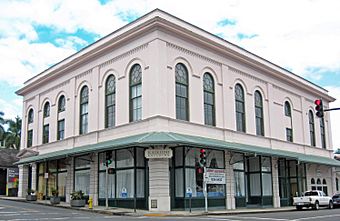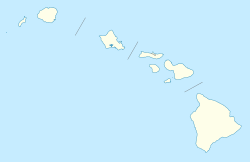Hilo Masonic Lodge Hall–Bishop Trust Building facts for kids
Quick facts for kids |
|
|
Hilo Masonic Lodge Hall–
Bishop Trust Building |
|

Vacant first floor in 2009
|
|
| Location | Keawe and Waianuenue Streets, Hilo, Hawaii |
|---|---|
| Area | 0.9 acres (0.36 ha) |
| Built | 1908–1910 |
| Architect | Henry F. Starbuck |
| Architectural style | Renaissance Revival |
| NRHP reference No. | 94000383 |
| Added to NRHP | April 21, 1994 |
The Hilo Masonic Lodge Hall, also known as the Bishop Trust Building, is a really old and important building in Hilo, Hawaii. It was built a long time ago, between 1908 and 1910. It was designed to have shops and offices on the first floor and a special meeting place for a group called the Masons on the second floor. The Masons used this building until about 1985.
Contents
A Look Back: The Lodge's Story
The Masonic Lodge in Hilo started in 1896. It was officially given its charter (a special document that makes it official) on October 15, 1897. They named it Kilauea Lodge #330, after the famous Kīlauea volcano nearby. This was the very first Masonic lodge on Hawaiʻi Island.
A man named John Troup Moir was in charge of the lodge. He also managed a sugarcane farm called Onomea plantation in Papaikou, Hawaii. In February 1898, a group from California officially gave the Kīlauea lodge its charter.
Finding a Home
At first, the lodge met in a building owned by Frederick S. Lyman. This building was on land that the lodge didn't own. So, the Masons formed a group to buy their own land. They hoped Hilo would grow towards this new spot. By October 1900, they had enough money to buy the land they wanted.
Around the same time, a new federal building was being planned in Hilo. The Masons tried to trade their land for a piece of the federal land. At first, people protested this idea. But by January 1906, they made a deal with the Territorial Governor, George R. Carter. They swapped their land (which was wanted for a school) for a more central piece of land, paying a bit extra for it.
Designing the Building
The Masons chose Henry F. Starbuck from Oakland, California to design their new building. He was also a Mason and had designed other lodges and churches. The plans for the building were ready by March 1906. Construction was supposed to start in July.
Building Challenges
Less than a month after the plans were ready, the big 1906 San Francisco earthquake happened. This made it hard to find building materials, and they became very expensive. This caused delays and made the Hilo project cost more than planned.
Finally, construction began in May 1908. Henry Starbuck came to Hilo to watch over the work. But after a few months, he and his workers were replaced. Fred Harrison from Honolulu took over the construction. The first stone of the building was laid on February 18, 1909. The building was officially opened on February 24, 1910. The final cost was twice what they had planned!
At the opening ceremony, John Troup Moir said the Masons wanted "nothing but the best." He called it a "strong, fireproof, earthquakeproof, up-to-date building." He said it was a credit to Hilo and Hawaii.
The Building's Features
The building is about 28,000-square-foot (2,600 m2) big. It was built using reinforced concrete in a style called Renaissance Revival. It has three floors and a full basement. Inside, a fancy granite staircase with an oak railing leads to the upper floors. The roof used to have a garden.
The second floor had a main entrance area, a special ceremonial room about 35 feet (11 m) by 55 feet (17 m), and a banquet room of similar size. The ceremonial room had high ceilings and special brass lights.
The Masons used the second and third floors until about 1985. They had to leave because their rules did not allow them to share the building with a business that sold alcohol. A liquor license was given to a business on the ground floor, so the Masons moved out.
Bringing the Building Back to Life
In 1992, a company called Toyama Hawaii, Inc. bought the building. It was added to Hawaii's list of historic places in 1993. Then, on April 21, 1994, it was added to the National Register of Historic Places listings on the island of Hawaii, which is a national list of important historic sites.
The ground floor of the building has had many different businesses over the years. Bishop Bank (which is now First Hawaiian Bank) used the ground floor before they moved to their own building.
In the 1990s, the building was fixed up. New restrooms were built, and an elevator was added. They used some of the original materials to keep its historic look. In 2001, Howard and Mary Ann Rogers bought the building. They opened a restaurant called Kaikodo in 2003 on the ground floor. They also planned to open an Asian art gallery on the second floor.
The Kaikodo restaurant closed in 2007, and the building was put up for sale. Another restaurant opened in 2009 called "Uncle Don's Ohana Grill," but it closed less than a year later.
The building is located at 60 Keawe Street, on the corner of Keawe and Waianuenue Streets in Hilo. Today, the Kilauea lodge is one of only two Masonic lodges on the island.


